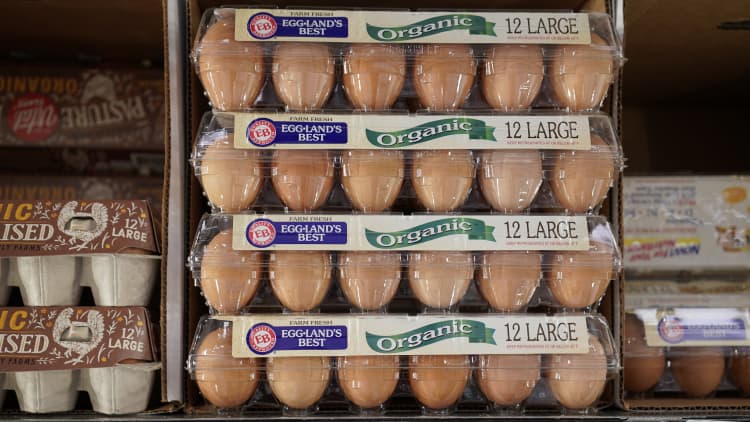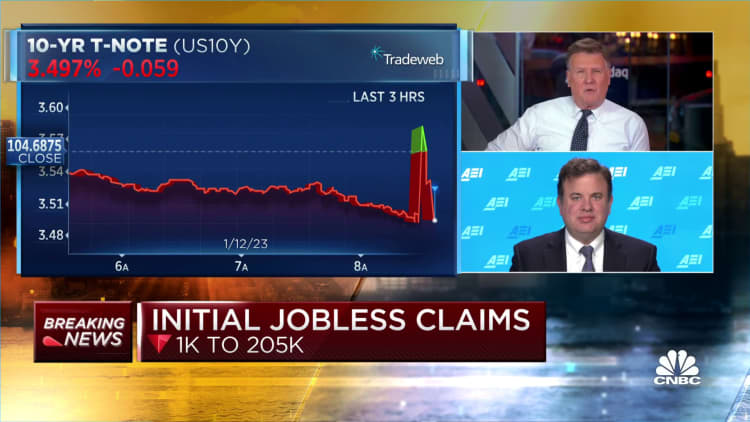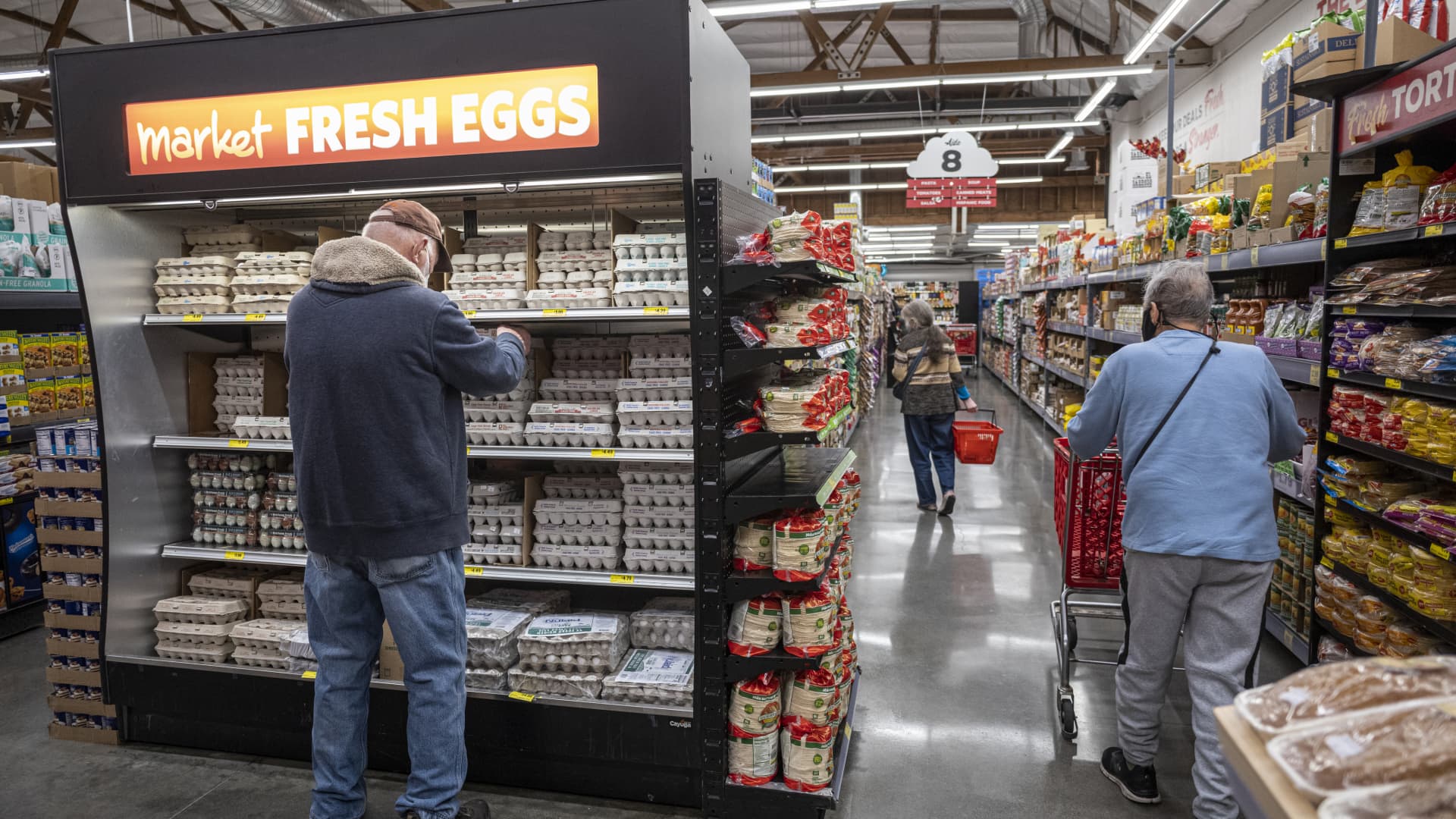David Paul Morris/Bloomberg via Getty Images
Inflation popped in 2022 to a level unseen in four decades.
But prices ballooned more rapidly for certain items than others, largely concentrated among food, fuel and airfare.
Some of those swings were due to outlying factors that extended beyond broad inflationary pressures such as snarled supply chains, labor shortages, burgeoning consumer demand and Russia’s invasion of Ukraine.
Here’s a look at the 10 items with the largest price gains, as measured by the annual inflation rate in December. Percentages are from the latest consumer price index data, issued Thursday.
Food at school: 305.2%
The price of a meal at elementary and secondary schools spiked the most in 2022, by a whopping 305%.
In the early days of the pandemic, the federal government enacted a program offering free meals to all public-school students, regardless of family income. That program — which expanded an existing one for lower-income families — ended Sept. 30.
Overall food prices have been pressured on many fronts, too, funneling into school meals.
For example, respective annual inflation rates for groceries and meals away from home hit 13.5% and 8% in August — their highest since 1971 and 1981, respectively.
Russia’s invasion of Ukraine created an energy supply shock, contributing to higher transport costs to deliver food from farm to table. That combined with other factors such as higher labor costs to underpin fast-rising prices throughout the food complex.
“Food inflation has been nuts,” said Tim Mahedy, senior economist at KPMG. “We hadn’t seen [these levels] consistently really in decades.”
Eggs: 59.9%

Margarine: 43.8%
Global shocks in major markets for vegetable oil — a key ingredient in margarine — drove margarine prices up by 43.8% in 2022.
Prices for commodities such as soybean, palm, sunflower and rapeseed (also known as canola) oil tend to move together — meaning a supply disruption for one tends to affect the group, economists said.
For example, Ukraine is the No. 1 global producer and exporter of sunflower oil. The war there squeezed supplies.
Further, Indonesia accounts for over half the world’s palm oil; the country imposed a temporary ban on exports last year and other restrictions, such as an export levy. Severe drought in Canada — the world’s largest canola-oil exporter — throttled supply. And soybean yields in Brazil fell due to weather conditions.
Fuel oil (41.5%) and motor fuels (32.3%)
When crude-oil prices spiked in the first half of the year, so did those of its refined byproducts.
Russia’s full-scale invasion of Ukraine started Feb. 24. By March 8, a barrel of crude oil had hit its highest inflation-adjusted price since 2014, amid concerns about the war’s impact on supply, according to the U.S. Energy Information Administration.
“It caused anything energy-related to jump,” said Mark Zandi, chief economist at Moody’s Analytics.
Oil prices retreated in the second half of the year, though, as fears mounted of a possible recession and an accompanying weakness in oil demand.
Gasoline prices fell, too, ending the year down 1.5%. But prices for other oil products haven’t declined as steeply. Fuel oil and other motor fuels such as diesel ended the year up 41.5% and 32.3%, respectively.
Butter (31.4%) and other dairy (21.4%)
A decline in global milk output — among major producers such as Australia, the European Union and New Zealand — squeezed prices for butter and other dairy products.
Monthly milk production among major suppliers fell each month from September 2021 to June 2022, according to the U.S. Department of Agriculture.
“They’ve all been pretty pressured in terms of available milk supply,” Amy Smith, vice president at Advanced Economic Solutions, a consulting firm specializing in food economics, said of the dairy complex.
Stephen Gibson / Eyeem | Eyeem | Getty Images
Output was stable in the U.S., which raised exports to plug the gap. U.S. dairy export volumes were up 5% in 2022 through October, relative to the same period in 2021, according to USDA data. Butter exports grew by 43% over that time — leading to a lower butter supply at home, economists said,
Further, Russia and Ukraine are major suppliers of wheat. The war impacted grain supplies, raising the price of animal feed and costs for farmers, economists said.
Butter prices ended 2022 up 31.4%. Other dairy products (excluding milk, cheese and ice cream) were up 21.4%.
Airline fares: 28.5%
Airfare was up almost 29% in 2022 as consumers with ample cash on hand unleashed a few years of pent-up wanderlust.
That demand ran headlong into airline industry shortages for pilots, many of whom were laid off or retired early in the pandemic. Jet-fuel costs surged and airlines flew fewer routes. These factors crimped the supply of airline seats, economists said.
“People have shifted their spending away from goods to travel, restaurants and ball games,” Zandi said. “Airplanes have been packed.”
However, average fares began retreating in October, November and December.
Lettuce: 24.9%
An insect-borne virus “raging” through the Salinas Valley growing region in California led lettuce prices to surge in 2022, said Mahedy of KPMG.
The region, which has been referred to as “America’s salad bowl,” accounts for about half of U.S. lettuce production, according to Aaron Smith, a professor of agricultural economics at the University of California, Davis.

Russia is also the world’s top fertilizer exporter. Prices for fertilizer — among farmers’ biggest costs — hit all-time highs in spring 2022 after Russia invaded Ukraine, according to the Federal Reserve Bank of St. Louis.
The price of vegetables and fruits were “significantly affected” by that run-up in prices, Zandi said.
Flour: 23.4%
Ukraine and Russia are major wheat exporters. The nations accounted for 28% of all exports globally in 2021, according to the USDA.
War led to uncertainty about export volumes and impact on the spring planting season, causing prices to spike. The price dynamic impacted flour, which is milled from wheat, Smith said.

